Analysis of Teacher-Student Relationship in Educational Settings
VerifiedAdded on 2021/04/17
|7
|1786
|60
Essay
AI Summary
This essay critically analyzes the relationship between teachers and students, emphasizing how stress and burnout affect this dynamic. It examines the evolution of this relationship and the factors contributing to teacher exhaustion, such as workload pressure and student behavior. The research, based on secondary data and potentially primary interviews, explores the correlation between teacher burnout and student outcomes, highlighting the impact of teacher characteristics, socialization, and behaviors. The findings suggest that teacher stress, often stemming from environmental factors and professional dissatisfaction, negatively influences the student-teacher relationship. The essay emphasizes the importance of emotional and psychological well-being for teachers to mitigate burnout and foster a positive learning environment. The study concludes that teachers' self-efficacy is linked to burnout, and addressing factors contributing to teacher stress is crucial for improving both teacher well-being and student success. References are provided to support the analysis.
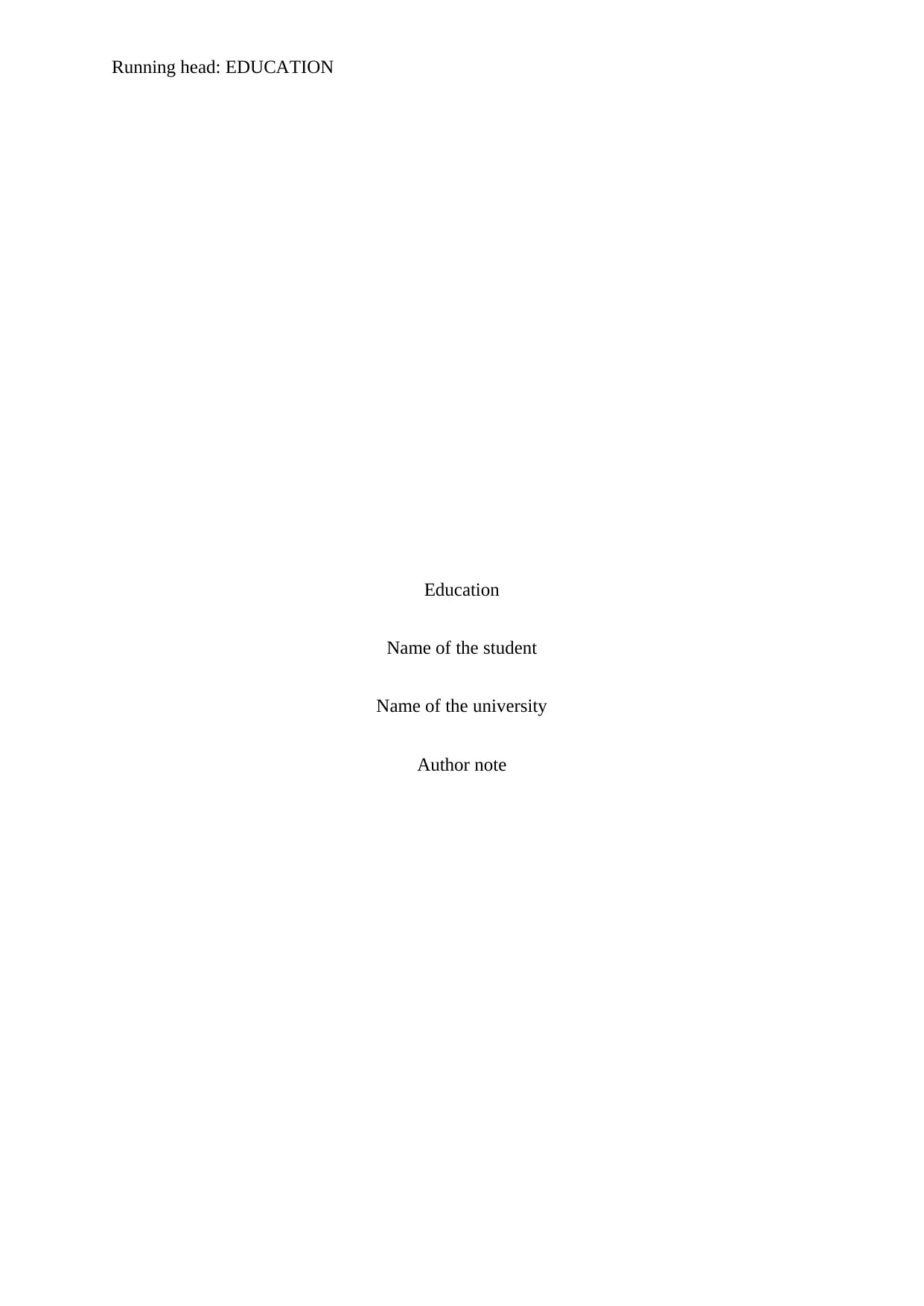
Running head: EDUCATION
Education
Name of the student
Name of the university
Author note
Education
Name of the student
Name of the university
Author note
Paraphrase This Document
Need a fresh take? Get an instant paraphrase of this document with our AI Paraphraser
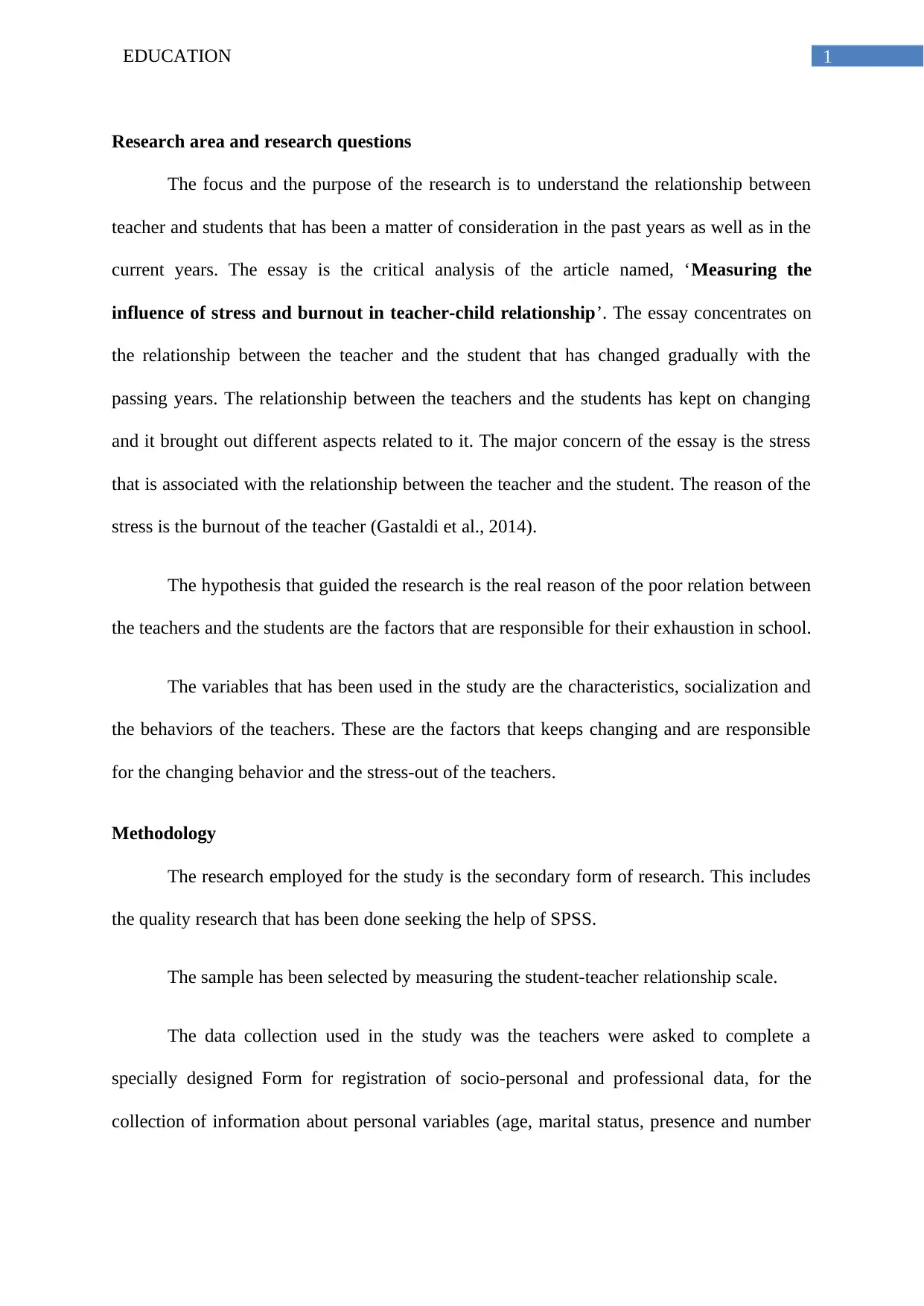
1EDUCATION
Research area and research questions
The focus and the purpose of the research is to understand the relationship between
teacher and students that has been a matter of consideration in the past years as well as in the
current years. The essay is the critical analysis of the article named, ‘Measuring the
influence of stress and burnout in teacher-child relationship’. The essay concentrates on
the relationship between the teacher and the student that has changed gradually with the
passing years. The relationship between the teachers and the students has kept on changing
and it brought out different aspects related to it. The major concern of the essay is the stress
that is associated with the relationship between the teacher and the student. The reason of the
stress is the burnout of the teacher (Gastaldi et al., 2014).
The hypothesis that guided the research is the real reason of the poor relation between
the teachers and the students are the factors that are responsible for their exhaustion in school.
The variables that has been used in the study are the characteristics, socialization and
the behaviors of the teachers. These are the factors that keeps changing and are responsible
for the changing behavior and the stress-out of the teachers.
Methodology
The research employed for the study is the secondary form of research. This includes
the quality research that has been done seeking the help of SPSS.
The sample has been selected by measuring the student-teacher relationship scale.
The data collection used in the study was the teachers were asked to complete a
specially designed Form for registration of socio-personal and professional data, for the
collection of information about personal variables (age, marital status, presence and number
Research area and research questions
The focus and the purpose of the research is to understand the relationship between
teacher and students that has been a matter of consideration in the past years as well as in the
current years. The essay is the critical analysis of the article named, ‘Measuring the
influence of stress and burnout in teacher-child relationship’. The essay concentrates on
the relationship between the teacher and the student that has changed gradually with the
passing years. The relationship between the teachers and the students has kept on changing
and it brought out different aspects related to it. The major concern of the essay is the stress
that is associated with the relationship between the teacher and the student. The reason of the
stress is the burnout of the teacher (Gastaldi et al., 2014).
The hypothesis that guided the research is the real reason of the poor relation between
the teachers and the students are the factors that are responsible for their exhaustion in school.
The variables that has been used in the study are the characteristics, socialization and
the behaviors of the teachers. These are the factors that keeps changing and are responsible
for the changing behavior and the stress-out of the teachers.
Methodology
The research employed for the study is the secondary form of research. This includes
the quality research that has been done seeking the help of SPSS.
The sample has been selected by measuring the student-teacher relationship scale.
The data collection used in the study was the teachers were asked to complete a
specially designed Form for registration of socio-personal and professional data, for the
collection of information about personal variables (age, marital status, presence and number
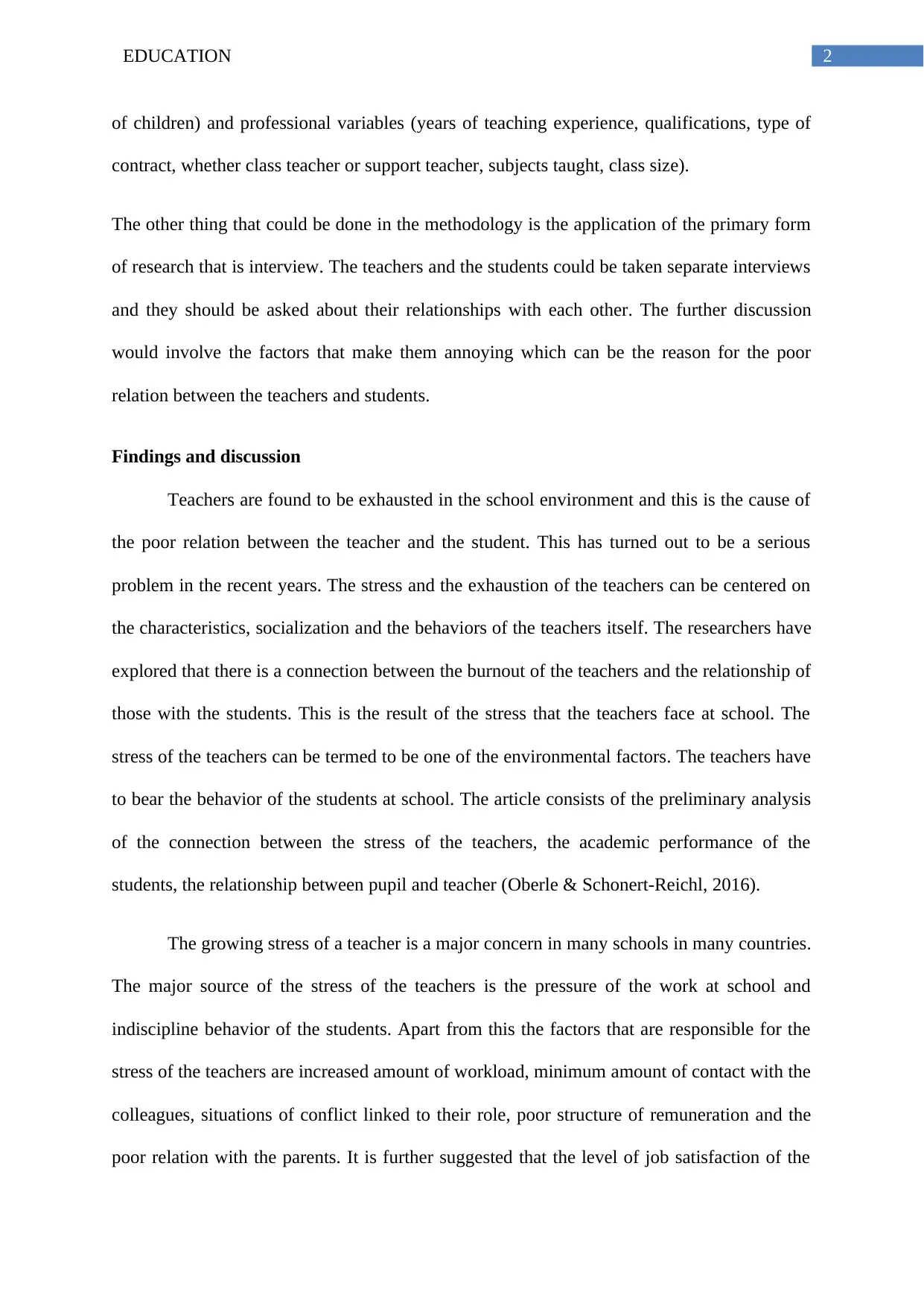
2EDUCATION
of children) and professional variables (years of teaching experience, qualifications, type of
contract, whether class teacher or support teacher, subjects taught, class size).
The other thing that could be done in the methodology is the application of the primary form
of research that is interview. The teachers and the students could be taken separate interviews
and they should be asked about their relationships with each other. The further discussion
would involve the factors that make them annoying which can be the reason for the poor
relation between the teachers and students.
Findings and discussion
Teachers are found to be exhausted in the school environment and this is the cause of
the poor relation between the teacher and the student. This has turned out to be a serious
problem in the recent years. The stress and the exhaustion of the teachers can be centered on
the characteristics, socialization and the behaviors of the teachers itself. The researchers have
explored that there is a connection between the burnout of the teachers and the relationship of
those with the students. This is the result of the stress that the teachers face at school. The
stress of the teachers can be termed to be one of the environmental factors. The teachers have
to bear the behavior of the students at school. The article consists of the preliminary analysis
of the connection between the stress of the teachers, the academic performance of the
students, the relationship between pupil and teacher (Oberle & Schonert-Reichl, 2016).
The growing stress of a teacher is a major concern in many schools in many countries.
The major source of the stress of the teachers is the pressure of the work at school and
indiscipline behavior of the students. Apart from this the factors that are responsible for the
stress of the teachers are increased amount of workload, minimum amount of contact with the
colleagues, situations of conflict linked to their role, poor structure of remuneration and the
poor relation with the parents. It is further suggested that the level of job satisfaction of the
of children) and professional variables (years of teaching experience, qualifications, type of
contract, whether class teacher or support teacher, subjects taught, class size).
The other thing that could be done in the methodology is the application of the primary form
of research that is interview. The teachers and the students could be taken separate interviews
and they should be asked about their relationships with each other. The further discussion
would involve the factors that make them annoying which can be the reason for the poor
relation between the teachers and students.
Findings and discussion
Teachers are found to be exhausted in the school environment and this is the cause of
the poor relation between the teacher and the student. This has turned out to be a serious
problem in the recent years. The stress and the exhaustion of the teachers can be centered on
the characteristics, socialization and the behaviors of the teachers itself. The researchers have
explored that there is a connection between the burnout of the teachers and the relationship of
those with the students. This is the result of the stress that the teachers face at school. The
stress of the teachers can be termed to be one of the environmental factors. The teachers have
to bear the behavior of the students at school. The article consists of the preliminary analysis
of the connection between the stress of the teachers, the academic performance of the
students, the relationship between pupil and teacher (Oberle & Schonert-Reichl, 2016).
The growing stress of a teacher is a major concern in many schools in many countries.
The major source of the stress of the teachers is the pressure of the work at school and
indiscipline behavior of the students. Apart from this the factors that are responsible for the
stress of the teachers are increased amount of workload, minimum amount of contact with the
colleagues, situations of conflict linked to their role, poor structure of remuneration and the
poor relation with the parents. It is further suggested that the level of job satisfaction of the
⊘ This is a preview!⊘
Do you want full access?
Subscribe today to unlock all pages.

Trusted by 1+ million students worldwide
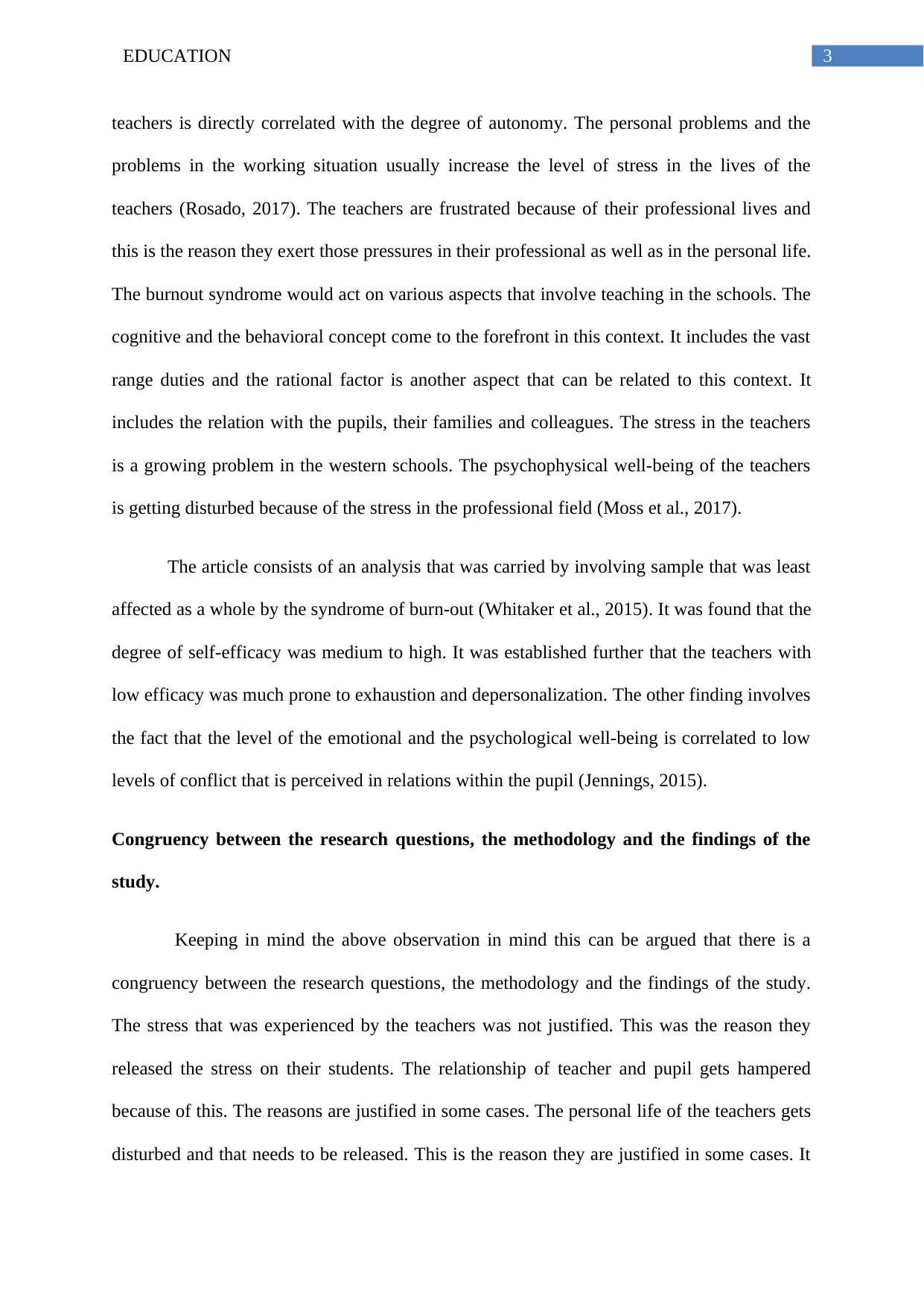
3EDUCATION
teachers is directly correlated with the degree of autonomy. The personal problems and the
problems in the working situation usually increase the level of stress in the lives of the
teachers (Rosado, 2017). The teachers are frustrated because of their professional lives and
this is the reason they exert those pressures in their professional as well as in the personal life.
The burnout syndrome would act on various aspects that involve teaching in the schools. The
cognitive and the behavioral concept come to the forefront in this context. It includes the vast
range duties and the rational factor is another aspect that can be related to this context. It
includes the relation with the pupils, their families and colleagues. The stress in the teachers
is a growing problem in the western schools. The psychophysical well-being of the teachers
is getting disturbed because of the stress in the professional field (Moss et al., 2017).
The article consists of an analysis that was carried by involving sample that was least
affected as a whole by the syndrome of burn-out (Whitaker et al., 2015). It was found that the
degree of self-efficacy was medium to high. It was established further that the teachers with
low efficacy was much prone to exhaustion and depersonalization. The other finding involves
the fact that the level of the emotional and the psychological well-being is correlated to low
levels of conflict that is perceived in relations within the pupil (Jennings, 2015).
Congruency between the research questions, the methodology and the findings of the
study.
Keeping in mind the above observation in mind this can be argued that there is a
congruency between the research questions, the methodology and the findings of the study.
The stress that was experienced by the teachers was not justified. This was the reason they
released the stress on their students. The relationship of teacher and pupil gets hampered
because of this. The reasons are justified in some cases. The personal life of the teachers gets
disturbed and that needs to be released. This is the reason they are justified in some cases. It
teachers is directly correlated with the degree of autonomy. The personal problems and the
problems in the working situation usually increase the level of stress in the lives of the
teachers (Rosado, 2017). The teachers are frustrated because of their professional lives and
this is the reason they exert those pressures in their professional as well as in the personal life.
The burnout syndrome would act on various aspects that involve teaching in the schools. The
cognitive and the behavioral concept come to the forefront in this context. It includes the vast
range duties and the rational factor is another aspect that can be related to this context. It
includes the relation with the pupils, their families and colleagues. The stress in the teachers
is a growing problem in the western schools. The psychophysical well-being of the teachers
is getting disturbed because of the stress in the professional field (Moss et al., 2017).
The article consists of an analysis that was carried by involving sample that was least
affected as a whole by the syndrome of burn-out (Whitaker et al., 2015). It was found that the
degree of self-efficacy was medium to high. It was established further that the teachers with
low efficacy was much prone to exhaustion and depersonalization. The other finding involves
the fact that the level of the emotional and the psychological well-being is correlated to low
levels of conflict that is perceived in relations within the pupil (Jennings, 2015).
Congruency between the research questions, the methodology and the findings of the
study.
Keeping in mind the above observation in mind this can be argued that there is a
congruency between the research questions, the methodology and the findings of the study.
The stress that was experienced by the teachers was not justified. This was the reason they
released the stress on their students. The relationship of teacher and pupil gets hampered
because of this. The reasons are justified in some cases. The personal life of the teachers gets
disturbed and that needs to be released. This is the reason they are justified in some cases. It
Paraphrase This Document
Need a fresh take? Get an instant paraphrase of this document with our AI Paraphraser
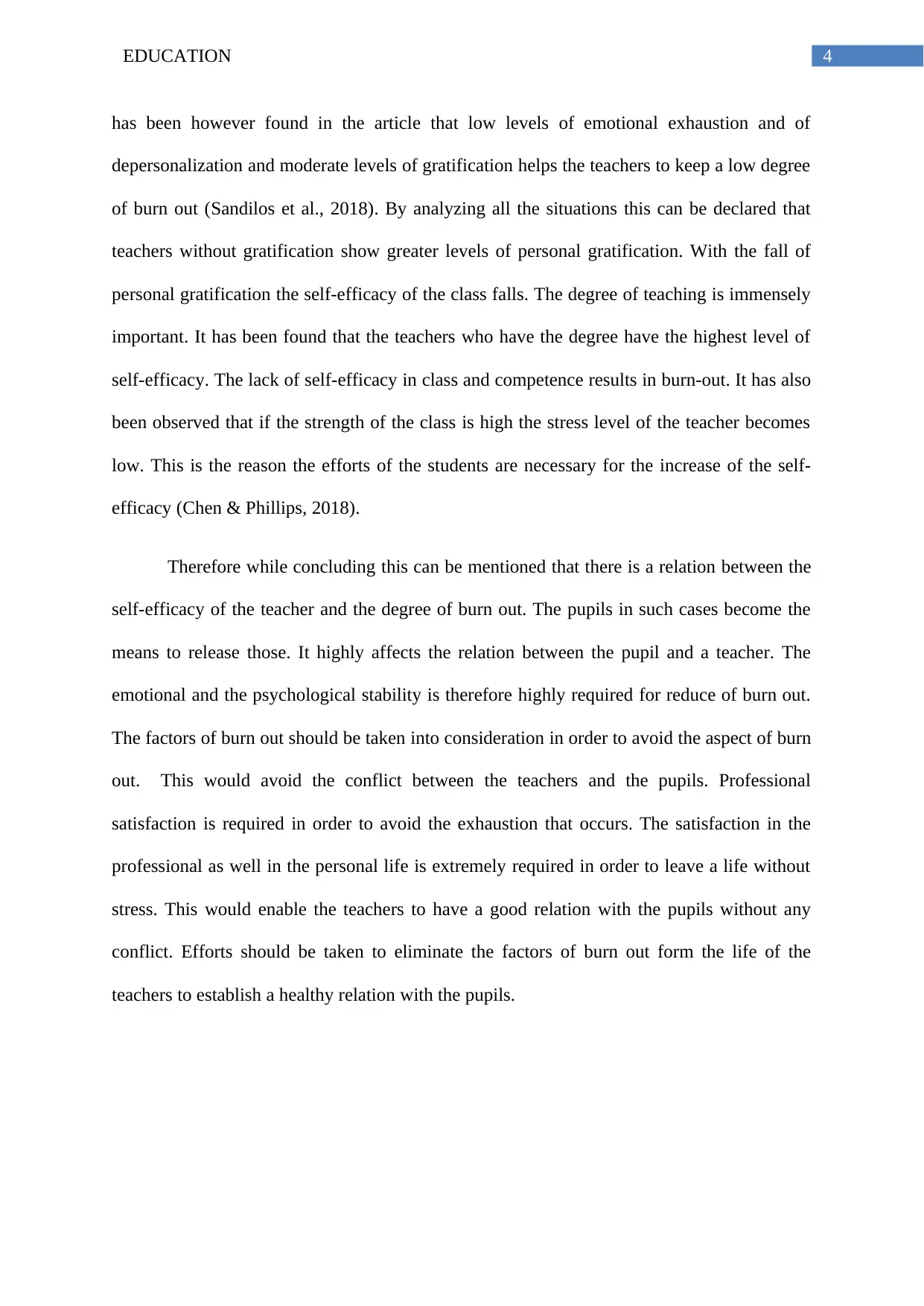
4EDUCATION
has been however found in the article that low levels of emotional exhaustion and of
depersonalization and moderate levels of gratification helps the teachers to keep a low degree
of burn out (Sandilos et al., 2018). By analyzing all the situations this can be declared that
teachers without gratification show greater levels of personal gratification. With the fall of
personal gratification the self-efficacy of the class falls. The degree of teaching is immensely
important. It has been found that the teachers who have the degree have the highest level of
self-efficacy. The lack of self-efficacy in class and competence results in burn-out. It has also
been observed that if the strength of the class is high the stress level of the teacher becomes
low. This is the reason the efforts of the students are necessary for the increase of the self-
efficacy (Chen & Phillips, 2018).
Therefore while concluding this can be mentioned that there is a relation between the
self-efficacy of the teacher and the degree of burn out. The pupils in such cases become the
means to release those. It highly affects the relation between the pupil and a teacher. The
emotional and the psychological stability is therefore highly required for reduce of burn out.
The factors of burn out should be taken into consideration in order to avoid the aspect of burn
out. This would avoid the conflict between the teachers and the pupils. Professional
satisfaction is required in order to avoid the exhaustion that occurs. The satisfaction in the
professional as well in the personal life is extremely required in order to leave a life without
stress. This would enable the teachers to have a good relation with the pupils without any
conflict. Efforts should be taken to eliminate the factors of burn out form the life of the
teachers to establish a healthy relation with the pupils.
has been however found in the article that low levels of emotional exhaustion and of
depersonalization and moderate levels of gratification helps the teachers to keep a low degree
of burn out (Sandilos et al., 2018). By analyzing all the situations this can be declared that
teachers without gratification show greater levels of personal gratification. With the fall of
personal gratification the self-efficacy of the class falls. The degree of teaching is immensely
important. It has been found that the teachers who have the degree have the highest level of
self-efficacy. The lack of self-efficacy in class and competence results in burn-out. It has also
been observed that if the strength of the class is high the stress level of the teacher becomes
low. This is the reason the efforts of the students are necessary for the increase of the self-
efficacy (Chen & Phillips, 2018).
Therefore while concluding this can be mentioned that there is a relation between the
self-efficacy of the teacher and the degree of burn out. The pupils in such cases become the
means to release those. It highly affects the relation between the pupil and a teacher. The
emotional and the psychological stability is therefore highly required for reduce of burn out.
The factors of burn out should be taken into consideration in order to avoid the aspect of burn
out. This would avoid the conflict between the teachers and the pupils. Professional
satisfaction is required in order to avoid the exhaustion that occurs. The satisfaction in the
professional as well in the personal life is extremely required in order to leave a life without
stress. This would enable the teachers to have a good relation with the pupils without any
conflict. Efforts should be taken to eliminate the factors of burn out form the life of the
teachers to establish a healthy relation with the pupils.
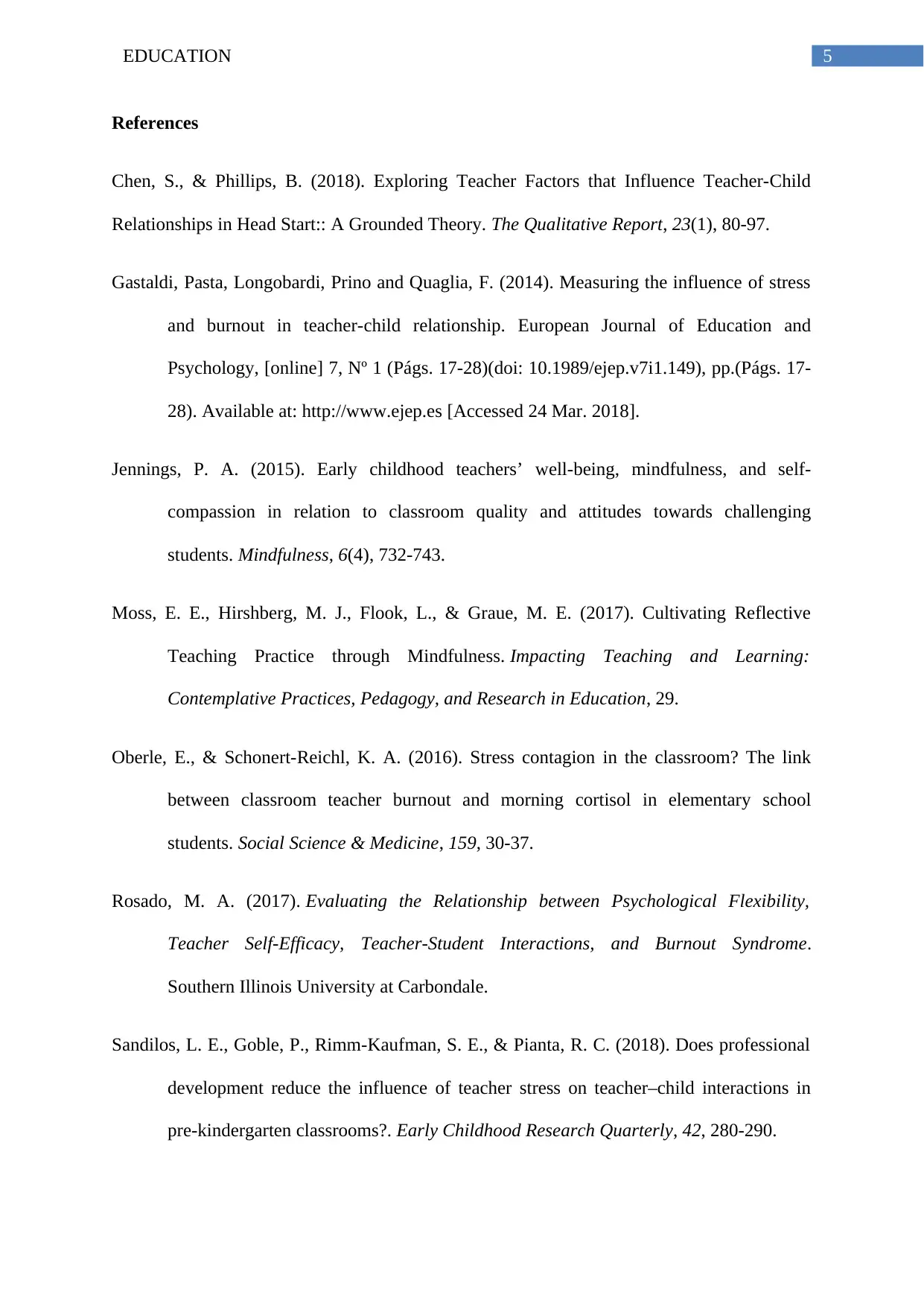
5EDUCATION
References
Chen, S., & Phillips, B. (2018). Exploring Teacher Factors that Influence Teacher-Child
Relationships in Head Start:: A Grounded Theory. The Qualitative Report, 23(1), 80-97.
Gastaldi, Pasta, Longobardi, Prino and Quaglia, F. (2014). Measuring the influence of stress
and burnout in teacher-child relationship. European Journal of Education and
Psychology, [online] 7, Nº 1 (Págs. 17-28)(doi: 10.1989/ejep.v7i1.149), pp.(Págs. 17-
28). Available at: http://www.ejep.es [Accessed 24 Mar. 2018].
Jennings, P. A. (2015). Early childhood teachers’ well-being, mindfulness, and self-
compassion in relation to classroom quality and attitudes towards challenging
students. Mindfulness, 6(4), 732-743.
Moss, E. E., Hirshberg, M. J., Flook, L., & Graue, M. E. (2017). Cultivating Reflective
Teaching Practice through Mindfulness. Impacting Teaching and Learning:
Contemplative Practices, Pedagogy, and Research in Education, 29.
Oberle, E., & Schonert-Reichl, K. A. (2016). Stress contagion in the classroom? The link
between classroom teacher burnout and morning cortisol in elementary school
students. Social Science & Medicine, 159, 30-37.
Rosado, M. A. (2017). Evaluating the Relationship between Psychological Flexibility,
Teacher Self-Efficacy, Teacher-Student Interactions, and Burnout Syndrome.
Southern Illinois University at Carbondale.
Sandilos, L. E., Goble, P., Rimm-Kaufman, S. E., & Pianta, R. C. (2018). Does professional
development reduce the influence of teacher stress on teacher–child interactions in
pre-kindergarten classrooms?. Early Childhood Research Quarterly, 42, 280-290.
References
Chen, S., & Phillips, B. (2018). Exploring Teacher Factors that Influence Teacher-Child
Relationships in Head Start:: A Grounded Theory. The Qualitative Report, 23(1), 80-97.
Gastaldi, Pasta, Longobardi, Prino and Quaglia, F. (2014). Measuring the influence of stress
and burnout in teacher-child relationship. European Journal of Education and
Psychology, [online] 7, Nº 1 (Págs. 17-28)(doi: 10.1989/ejep.v7i1.149), pp.(Págs. 17-
28). Available at: http://www.ejep.es [Accessed 24 Mar. 2018].
Jennings, P. A. (2015). Early childhood teachers’ well-being, mindfulness, and self-
compassion in relation to classroom quality and attitudes towards challenging
students. Mindfulness, 6(4), 732-743.
Moss, E. E., Hirshberg, M. J., Flook, L., & Graue, M. E. (2017). Cultivating Reflective
Teaching Practice through Mindfulness. Impacting Teaching and Learning:
Contemplative Practices, Pedagogy, and Research in Education, 29.
Oberle, E., & Schonert-Reichl, K. A. (2016). Stress contagion in the classroom? The link
between classroom teacher burnout and morning cortisol in elementary school
students. Social Science & Medicine, 159, 30-37.
Rosado, M. A. (2017). Evaluating the Relationship between Psychological Flexibility,
Teacher Self-Efficacy, Teacher-Student Interactions, and Burnout Syndrome.
Southern Illinois University at Carbondale.
Sandilos, L. E., Goble, P., Rimm-Kaufman, S. E., & Pianta, R. C. (2018). Does professional
development reduce the influence of teacher stress on teacher–child interactions in
pre-kindergarten classrooms?. Early Childhood Research Quarterly, 42, 280-290.
⊘ This is a preview!⊘
Do you want full access?
Subscribe today to unlock all pages.

Trusted by 1+ million students worldwide
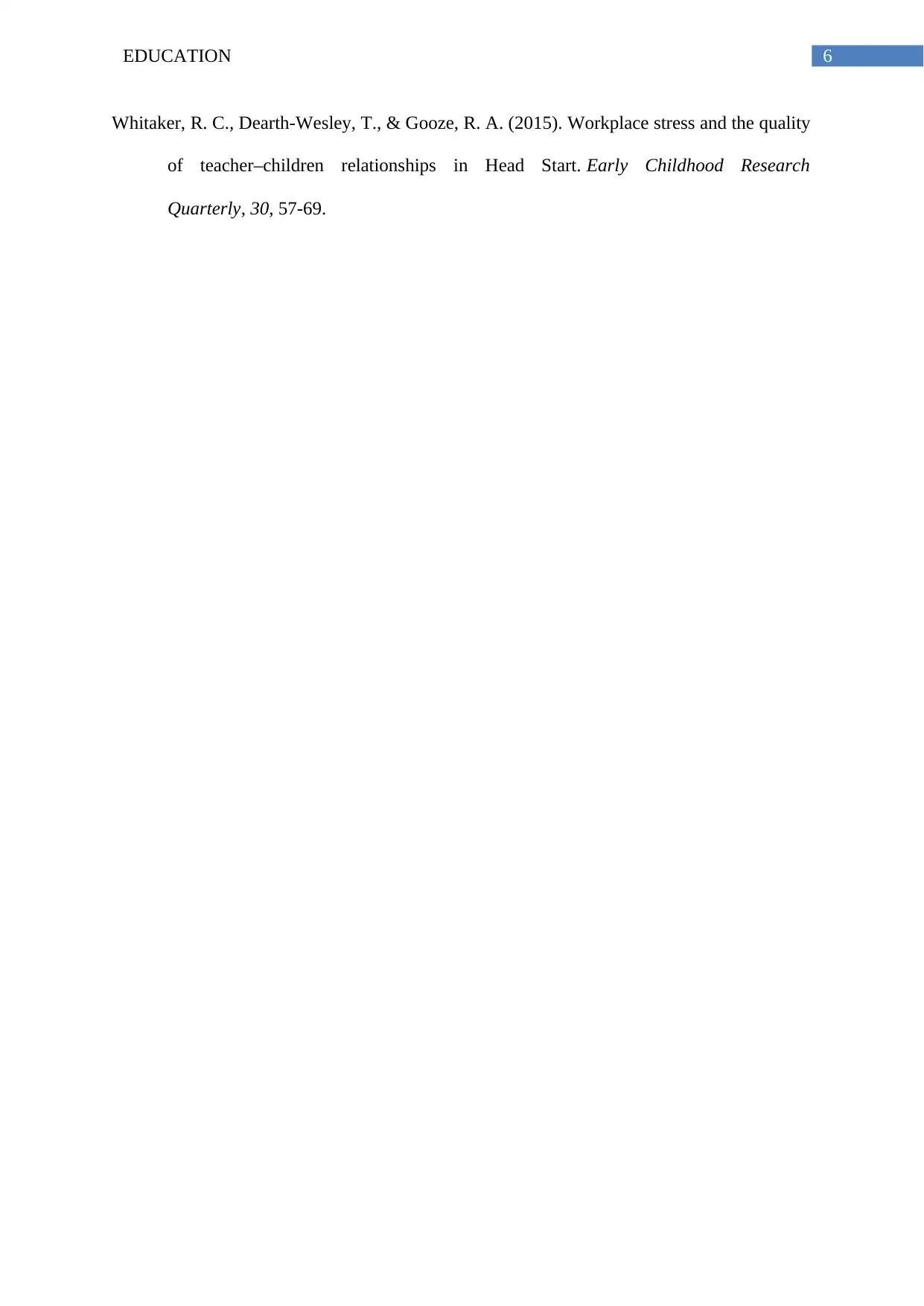
6EDUCATION
Whitaker, R. C., Dearth-Wesley, T., & Gooze, R. A. (2015). Workplace stress and the quality
of teacher–children relationships in Head Start. Early Childhood Research
Quarterly, 30, 57-69.
Whitaker, R. C., Dearth-Wesley, T., & Gooze, R. A. (2015). Workplace stress and the quality
of teacher–children relationships in Head Start. Early Childhood Research
Quarterly, 30, 57-69.
1 out of 7
Related Documents
Your All-in-One AI-Powered Toolkit for Academic Success.
+13062052269
info@desklib.com
Available 24*7 on WhatsApp / Email
![[object Object]](/_next/static/media/star-bottom.7253800d.svg)
Unlock your academic potential
Copyright © 2020–2025 A2Z Services. All Rights Reserved. Developed and managed by ZUCOL.





